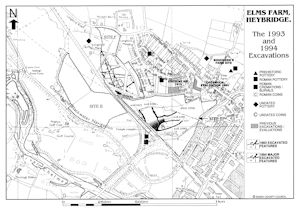
Cite this as: Hillam, J. 2015, Tree-Ring Analysis of Oak Timbers from Elms Farm, Heybridge, Essex, in M. Atkinson and S.J. Preston Heybridge: A Late Iron Age and Roman Settlement, Excavations at Elms Farm 1993-5, Internet Archaeology 40. http://dx.doi.org/10.11141/ia.40.1.hillam
Despite the shortness of most of the ring patterns, tree-ring dates were obtained for the Roman oak timbers from Elms Farm. Felling dates in the 2nd century AD were obtained for timbers from four wells, while a timber from a timber-lined ditch was felled after AD 215 and probably before AD 251. The study also produced a tree-ring chronology for the period AD 27-205.

This document is a technical report on the tree-ring analysis of oak timbers from Elms Farm, Heybridge (NGR TL847082). A detailed account of the excavations and location of the site is given in the Introduction and Site Narrative sections. The work presented here was largely completed by 1998.
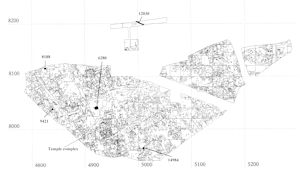
The remains of the Romano-British town at Heybridge lie on the north bank of the River Blackwater opposite the Saxon town of Maldon (Atkinson 1995). Excavations in 1994 revealed a temple complex and other associated buildings (Figures 693 and 694). Around these were the remains of several roads and a metalled surface area that could have been a marketplace. Although timber buildings would have been present, the only timbers preserved on the site were found in a series of wells and ditches.

Most of the tree-ring samples came from four Roman wells (Table 187), all of which had wooden box linings of similar construction (Figure 695).
Analysis was undertaken to provide precise dates for the timbers, and hence for the construction of the wells. It would also provide non-chronological data with which to augment the information collected from the wood technology studies. Finally, the tree-ring data themselves were seen as important. Most existing Roman chronologies are either from the central London area or Carlisle, and the majority are made up from 1st- or 2nd-century timbers. The Heybridge timbers therefore had the potential to extend the tree-ring databank, both geographically and temporally.
The samples were first frozen for at least 48 hours to consolidate the wood; they were then cleaned with a Surform plane, which highlights the boundaries of the annual growth rings. If the cross-sections were still not clear, an edge was pared with a Stanley knife.
Samples unsuitable for dating purposes were rejected at this stage. These included non-oak samples, samples with unmeasurable ring patterns owing to knots or narrow rings, and those with less than 30 rings. Normally, samples with less than 50 rings are rejected because their ring patterns may not be unique (Hillam 1998; Hillam et al. 1987). However, analysis of Iron Age timbers from Fiskerton in Lincolnshire had showed that samples with 30-50 rings can sometimes be dated reliably provided that longer ring sequences are available from the site and that there are several timbers per structure (Hillam 1998). In addition, some of the tangential planks from Elms Farm were clearly from the same tree (see below). Some were from the centre of the tree and therefore had more rings at the inside of the ring sequence, while others were from the outer part of the tree and had more rings at the outside. If all the samples with 30 or more rings were measured, some might be combined into ring sequences from the same tree with more than 50 rings.
The ring widths were measured to an accuracy of 0.01mm on a travelling stage connected to a microcomputer that uses a suite of dendrochronology programs written by Ian Tyers (1997). The ring width data were plotted as graphs. Crossmatching was carried out visually by comparing the graphs on a light box. A computer program was then used to measure the amount of correlation between the two ring sequences at the position of match found visually. The program uses crossmatching routines that are based on the Belfast CROS program (Baillie and Pilcher 1973; Munro 1984). Generally t-values of 3.5, or above, indicate a match, provided that the visual match between the tree-ring graphs is acceptable (Baillie 1982, 82-5). t-values over c. 10 usually indicate an origin in the same tree, although t-values less than 10 may be produced when different radii are measured on the same trunk. Visual matching and examination of the timbers themselves can sometimes aid the decision as to whether timbers come from the same tree but inevitably some same tree samples will go undetected by dendrochronology. When samples are thought to derive from the same tree, their ring widths are averaged to form a single sequence in order not to bias the site master curve.
The samples were examined structure by structure. Crossmatching was carried out visually by comparing the graphs from each well. Once visual crossmatching was complete, the matches were checked on the computer and t-values produced. The data from the matching sequences were then averaged to produce a master curve for each structure. When all the ring sequences had been crossmatched, the structure masters were compared against each other visually and by computer. They were also tested for similarity against dated reference chronologies using the computer. Any unmatched sequences were tested individually against the reference chronologies.
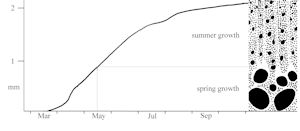
Once tree-ring dates have been obtained, calendar dates can be assigned to each of the annual rings within the sample, but the date of the outer ring is not necessarily equivalent to the year of felling. If a sample has bark or bark edge, the date of the last measured ring is the date in which the tree was felled. This can sometimes be refined even further (Figure 696).
The onset of wood formation each year varies within and between trees according to their genetic make-up and their environment. Trees that were actually felled at the same time therefore could appear from the tree-rings to be felled in 'winter' or 'spring' (Figure 696).
Partially formed rings are not measured so, for spring- and summer-felled trees, there will be a one-year discrepancy between the date of the last measured ring and the felling date. It is not always possible to distinguish between an incomplete ring and a complete narrow ring and therefore the season of felling is often indistinguishable. Sometimes the outer edge of a sample may be damaged because of the delicate nature of sapwood and, while it is known that bark edge was originally present, a few outer rings may have been lost. In cases such as these, the felling dates are precise to within a few years. Where bark edge is absent, felling dates are calculated using a sapwood estimate of 10-46 rings (Hillam 1998; see also Miles 1997). This is the range of the 95% confidence limits for the number of sapwood rings that best fits tree-ring data currently available at Sheffield (Tyers, pers. comm.). It replaces the previously used estimate of 10-55 rings (Hillam et al. 1987). Where sapwood is absent, felling dates are given as termini post quem (tpq) by adding ten years, the minimum number of missing sapwood rings, to the date of the last measured heartwood ring. This is the earliest possible felling date but the actual felling date could be much later depending on how many heartwood rings have been removed during conversion of the trunk into its component timbers.
The estimation of felling date ranges gives some indication of when a tree was felled. This information must then be related to the date that the timber was used. At this stage, factors such as seasoning, reuse, and/or stockpiling have to be considered. Seasoning is unlikely to have had an impact since timber was usually felled and used green until relatively recently. Examples of the use of green timber during the Roman period are given in Hollstein (1980). The reuse of timber has been a common practice since prehistoric times and stockpiling may also occur. Therefore, although the production of tree-ring dates is an independent process, the interpretation of these dates can sometimes be improved by drawing on other archaeological evidence such as that provided by the wood technologist.
The above gives a brief introduction to dendrochronology. Further information about the history, principles, and methodology of dendrochronology can be found in Baillie (1982) and Hillam (1998).

Initially twenty-four timbers were selected by Richard Darrah as being suitable for dendrochronology. Samples from these were analysed at Sheffield in 1996. These included plank 12030, which had 179 rings and dated easily. Most of the remaining samples initially appeared unsuitable for dating as they had less than 50 rings. Closer examination of the ring sequences from well 6280 showed that many were almost identical and obviously came from the same tree (Figures 697 and 698). The ring widths were therefore measured and matched together visually to produce an overall ring sequence that was over 50 years long. This proved datable, since it matched both 12030 and reference chronologies from other sites.
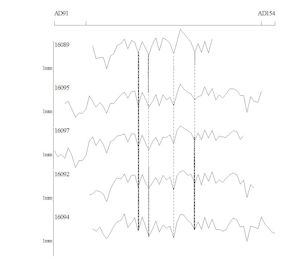
The results from this pilot study were so encouraging that the remaining timbers stored in Essex were assessed by members of the Sheffield laboratory and a further seventy-seven samples sent for analysis, a few of which were samples from the same timber. A total of sixty timbers, including those analysed in the pilot study, contained more than 30 rings and therefore for the purposes of this study were considered suitable for dating purposes (Table 187). Those that were assessed in Sheffield and found to be unsuitable are listed in the archive. The results are described for the assemblage as a whole, feature by feature; t-values for matches within and between structures, and against master chronologies, are listed in Table 188, Table 189, Table 190. Table 191, Table 192, Table 193. Where more than one sample was taken from a timber, each sample was measured and the ring widths combined to produce a single sequence. This proved useful because multiple sampling, presumably from different ends of the timber, often increased the length of the ring sequence for the timber.
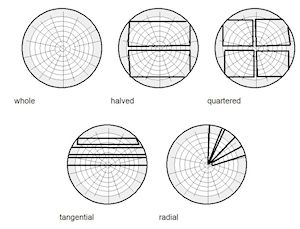
Most of the timbers were tangential planks (Figure 699). Exceptions were the stakes from well 14984, which were shaped from halved or quartered trunks, and the timbers from post-hole 6027 and ditch 12046 (Table 187). 6066 was a halved timber, 12030 was a radial plank, and 12143 was an almost complete trunk. With the exception of the radial plank 12030, which had 179 rings, most of the timbers were from young trees, probably less than 70 years old when felled. Average ring widths were usually over 2.0mm, and often over 3.0mm, indicating that the timbers came from trees subject to favourable conditions of growth.
Post 6066 had 45 heartwood rings, but its ring sequence could not be dated.
12143 could not be dated. It contained 32 rings, including 14 sapwood rings and bark edge; it was felled in winter. 12030, by contrast, was the key to dating all the timbers from Elms Farm. It had 179 rings and possible heartwood-sapwood boundary. Its ring sequence was dated to AD 27-205 by comparison to dated reference chronologies (Table 193).
Timbers 16083, 16144, and 16146 from the fill had 32, 39, and 47 heartwood rings respectively; none of their ring sequences were datable. The top two layers of planks from the lining had almost identical ring patterns and were probably from the same tree (Figures 697 and 698). These were combined to produce a single sequence of 71 rings. This matched the ring sequence from plank 16117, a broken plank from the fill, with a t-value of 6.0. The t-values for all the matches are set out in Table 188. A master, 6280-T2, of 79 years was produced for the structure. This was dated by comparison with other structure masters and dated reference chronologies to AD 83-161 (Table 192 and Table 193). The remaining samples from the lower layers of the lining failed to date either against other Elms Farm sequences or dated reference chronologies. Timber 16132, which bore the stamp 'SV', had only 27 rings and was unsuitable for dating purposes.
The eleven measured timbers from the lining of this well crossmatched to give a structure master of 68 rings (8188-T7), which dated to AD 92-159 (Table 189, Table 192 and Table 193). Five timbers probably derive from a single tree: 8199, 8201, 8217, 8218, and 8219.
The eleven measured timbers from the lining of this well crossmatched to give a structure master of 69 rings (9421-T9), which dated to AD 67-135 (Table 190, Table 192 and Table 193). Two pairs of timbers were thought to derive each from single trees: 9066/9901 and 9886/9907. Although the t-values for this structure are not very high, the visual matching was good. The fact that the ring patterns from 9421 are shorter than those from other features probably contributes to the lower t-values.
Fourteen ring sequences crossmatched from this structure (Table 191). Correlation between the ring patterns was acceptable but generally less good than for the other wells. This may be partly due to the fact that the 14984 timbers had fewer rings; it may also indicate that they are a more disparate group of timbers. The 50-year structure master, 14984-T11, was dated to AD 104-153 by comparison with other structure masters and dated reference chronologies (Table 192 and Table 193). Among the dated timbers were one from the fill, eight from the lining, and five stakes. Two groups of same trees were identified:
It is possible that stake 20247 belongs to the first group while lining timber 20076 may belong to the second, but given the uncertainty, they will be treated as different trees. 14971 from the second group was thought during excavation to be from the 4th-century fill but these results indicate that it comes from the well lining instead. The interpretation of the tree-ring dates from the stakes and the lining will be discussed below.

The matches between the structure masters are illustrated in Figure 700. In view of the shortness of some of the ring patterns, each structure master was tested against all reference data from 400 BC to the present. No alternative dates were indicated. Data from the structure masters and 12130 were therefore combined to produce an Elms Farm site chronology that dates to AD 27-205 (Table 194) (.xlsx). Although represented by only a single sample over much of its length (Figure 702), it is valuable reference data. Levels of crossmatching between it and other reference chronologies are shown in Table 193.
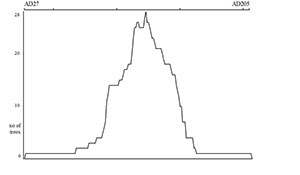
The tree-ring dates are summarised in Figure 702. The resulting felling dates or felling date ranges from each dated timber can then be used to obtain the date of use of the timbers. Since none of the timbers showed any signs of reuse and the heartwood-sapwood boundaries are consistent with an assemblage felled at one time, these can be used as construction dates for the structures.
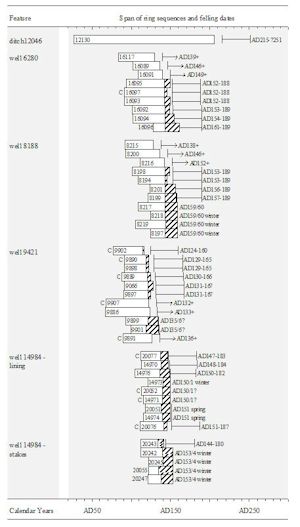
The date of the possible heartwood-sapwood boundary on lining timber 12030 is AD 205. If a sapwood estimate of 10-46 rings is applied, a felling date after AD 215 and probably before AD 251 is obtained.
Plank 16117 from the fill, which was possibly from the above-ground superstructure, has a last measured heartwood ring of AD 129 and was therefore felled some time after AD 139. The remaining timbers, which comprise the top two layers of planks from the lining, are probably all from the same tree. They have a combined felling date range of AD 161-188. However, timber 161096, which has an outer sapwood ring dating to AD 161, appears to be from the outside of the trunk. It is therefore possible that felling was soon after AD 161.
Four of the dated samples, three from the same tree, had bark edge and were felled in the winter of AD 159/60. Two others, 8199 and 8201, are probably from the same tree and therefore also felled at this time. 8194 and 8198 contained some sapwood rings and were both felled during the period AD 153-189. The other three samples, 8200, 8215, and 8216, had no sapwood and were felled after AD 146, AD 138, and AD 152 respectively. The closeness in date of the heartwood-sapwood boundaries suggests that the timbers were felled at the same time (Baillie 1982, 57) or within a few years of each other. Since the use of green timber was known to occur in the Roman period, a construction date of AD 159/60 or soon after is obtained for the wooden box lining of well 8188.
The dates of the heartwood-sapwood boundaries or the last measured heartwood rings range from AD 114 for 9902 to AD 126 for 9891, which suggests a group of timbers felled at the same time or within a few years of each other. The outer rings of 9899 and 9901 (and by inference 9066, which is probably from the same tree as 9901) were thought to be bark edge. The timbers were therefore probably felled in AD 135/6. 9891 does not have sapwood, but has an estimated terminus post quem for felling of AD 136. This is based on a sapwood estimate with 95% confidence limits so there is a 1 in 20 chance that a timber might have less than 10 rings or more than 46. A construction date of AD 135/6 or just after is therefore suggested for the lining of this well.
Two distinct phases are identified for this well. The stakes, 20055, 20242, 20245, and 20247, were all felled in the winter of AD 153/4. The lining timbers, however, seem to have been felled a few years earlier. 14971, 14973, 14974, 20051, and 20052 were felled either in the winter of AD 150/1 or the spring of AD 151. Since this could be the same time (see above), felling in April/May of AD 151 is postulated for these timbers. 20076 could have been felled at the same time since it may be from the same tree as 14971/14974/20051. The remaining dated timbers do not have full sapwood and so it is not possible to assign them to either of these phases.
The tree-ring results can be summarised to produce the following chronology for the site:
| AD 135/6 or just after | box lining of well 9421 constructed |
| AD 151, spring | box lining of well 14984 constructed |
| AD 153/4 or just after | stakes added to well 14984 |
| AD 159/60 or just after | box lining of well 8188 constructed |
| AD 161-89 (?nearer AD 161) | box lining of well 6280 constructed |
| AD 215-?251 | ditch 12046 lined with timber |
The production of the wooden box linings appears to be a single phase of construction in each case with timbers felled at the same time for each well or within a few years of each other. Well 14984 is more complex. The lining was made of timbers felled in the spring of AD 151 but was surrounded by stakes felled in the winter of AD 153/4. Two explanations are possible. The first is that the box lining was built in AD 151 or just after but proved to be unsteady and was therefore strengthened with stakes felled in AD 153/4. The alternative is that at least some of the timbers were felled and stockpiled for a few years. The lining and stakes would then have been inserted some time in or just after AD 153/4. There is no archaeological evidence to help resolve this problem since conditions were too wet during excavation to allow a detailed examination of the stratigraphy. However, since there is no obvious evidence of stockpiling of timbers for the other wells, the first explanation seems to be more likely, particularly as the t-values within and between the two groups suggest that the lining timbers and stakes may have come from different sources (Table 191).
The only other Roman well in the region to produce timbers for dendrochronology is well 567 from Great Holts Farm, Boreham. Only four timbers were salvaged, the others being removed by machinery before they could be excavated. The timbers, probably two pairs from two trees, were felled after AD 188 (Groves, pers. comm.). The well lining is therefore probably later than those at Elms Farm; no details of its construction are available.
Tree-ring dates were obtained for all the main timber-producing features. Presence of bark edge on many of the timbers resulted in the production of precise felling dates which indicated that the wells - or at least their box linings - were constructed in the 2nd century AD. The stakes around well 14984 were not Saxon but were felled in winter AD 153/4, a few years after the trees that were used for the lining planks. Ditch 12046 was lined in the 3rd century AD, probably in the first half. The study illustrates the value of using timbers with fewer rings than is usual in British dendrochronology and proves that, provided there are several timbers per structure and that at least one has more than 100 rings, it is possible to date timbers with 30-50 rings. The resulting site chronology from Elms Farm spans the period AD 27-205.
Internet Archaeology is an open access journal based in the Department of Archaeology, University of York. Except where otherwise noted, content from this work may be used under the terms of the Creative Commons Attribution 3.0 (CC BY) Unported licence, which permits unrestricted use, distribution, and reproduction in any medium, provided that attribution to the author(s), the title of the work, the Internet Archaeology journal and the relevant URL/DOI are given.
Terms and Conditions | Legal Statements | Privacy Policy | Cookies Policy | Citing Internet Archaeology
Internet Archaeology content is preserved for the long term with the Archaeology Data Service. Help sustain and support open access publication by donating to our Open Access Archaeology Fund.